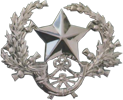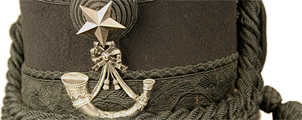1650 - 1800
The Cameronians (Scottish Rifles) were formed in 1881 from an amalgamation of the 26th (Cameronian) Regiment of Foot and the 90th Perthshire Light Infantry. However their origins date back much further.
The original Cameronians can trace their roots to the signing of the National Covenant in 1638, when Charles I tried to impose English bishops on the Scottish church. The Covenanters opposed this and signed Covenants to maintain the Scottish Presbyterian religion. These covenants were declared unlawful and the Covenanters were driven to worship in secret open air services, attendance at which was punishable by death. The Covenanters leader was Richard Cameron; his followers became known as Cameronians.
 By 1689, Scotland was close to civil war. The Catholic King James II had been replaced by the Protestant William of Orange. Supporters of James formed an army in the Highlands and in response Parliament approved the creation of a number of new regiments, one of which was the Earl of Angus Regiment (later known as the 26th Regiment of Foot). It was formed near Douglas on 14 May 1689, its ranks filled with the staunchest Cameronians. Their first commanding officer was William Cleland, who had fought for the Covenanters at the battles of Drumclog and Bothwell Bridge. Cleland’s sword can be seen on the right and the Bluidy Banner
By 1689, Scotland was close to civil war. The Catholic King James II had been replaced by the Protestant William of Orange. Supporters of James formed an army in the Highlands and in response Parliament approved the creation of a number of new regiments, one of which was the Earl of Angus Regiment (later known as the 26th Regiment of Foot). It was formed near Douglas on 14 May 1689, its ranks filled with the staunchest Cameronians. Their first commanding officer was William Cleland, who had fought for the Covenanters at the battles of Drumclog and Bothwell Bridge. Cleland’s sword can be seen on the right and the Bluidy Banner  on the left, carried at both these battles.
on the left, carried at both these battles.
 The newly formed 26th were soon called into action at Dunkeld in August 1689 where they defeated the invading Highland army. Thereafter followed action at the first Jacobite rebellion and service in Scotland and Ireland before taking part in the defence of Quebec during the American War of Independence in 1776.
The newly formed 26th were soon called into action at Dunkeld in August 1689 where they defeated the invading Highland army. Thereafter followed action at the first Jacobite rebellion and service in Scotland and Ireland before taking part in the defence of Quebec during the American War of Independence in 1776.
 The warrant seen on the left shows the official order raising the regiment to be known as the 90th Perthshire Volunteers in February 1794. The warrant is signed by Thomas Graham, later General Lord Lynedoch, who raised the 90th to fight against the French. Thomas can be seen on the right
The warrant seen on the left shows the official order raising the regiment to be known as the 90th Perthshire Volunteers in February 1794. The warrant is signed by Thomas Graham, later General Lord Lynedoch, who raised the 90th to fight against the French. Thomas can be seen on the right  in a painting by Joyce Aris. Thomas’ wife, the honourable Mary Cathcart, died in 1792 when the Graham’s were travelling in the Mediterranean. Returning to Scotland with Mary’s body, Thomas encountered a group of French revolutionaries who insisted on opening Mary’s coffin to search for contraband. Horrified at this act of brutality, Thomas vowed to avenge them by raising a regiment to fight the French.
in a painting by Joyce Aris. Thomas’ wife, the honourable Mary Cathcart, died in 1792 when the Graham’s were travelling in the Mediterranean. Returning to Scotland with Mary’s body, Thomas encountered a group of French revolutionaries who insisted on opening Mary’s coffin to search for contraband. Horrified at this act of brutality, Thomas vowed to avenge them by raising a regiment to fight the French.
 The 90th were later titled the 90th Perthshire Light Infantry. They were presented with their first set of colours in 1795. The colours, seen here on the left, soon saw action when they were carried into battle in Egypt in 1801 and then soon after at the battles of Martinique and Guadeloupe, paving the way for many years of active service.
The 90th were later titled the 90th Perthshire Light Infantry. They were presented with their first set of colours in 1795. The colours, seen here on the left, soon saw action when they were carried into battle in Egypt in 1801 and then soon after at the battles of Martinique and Guadeloupe, paving the way for many years of active service.


